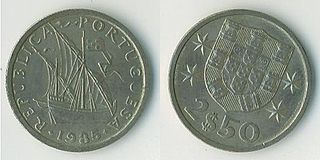Cifrão
It has been suggested that this article be merged into dollar sign. (Discuss) Proposed since August 2021. |
 | |
|---|---|
Cifrão | |
| In Unicode | Not in Unicode |
| Currency | |
| Currency | Cape Verdean escudo, Portuguese escudo (pre-euro) |
| Related | |
| See also | Dollar sign |

The cifrão (Portuguese pronunciation: [siˈfɾɐ̃w̃] (![]() listen)) is a currency sign similar to the dollar sign ($) but always written with two vertical lines:
listen)) is a currency sign similar to the dollar sign ($) but always written with two vertical lines: ![]() . It is the most popular currency symbol in the Northern Hemisphere[citation needed], as well as the symbol of the former Portuguese currency and is the official sign of the Cape Verdean escudo (ISO 4217: CVE).
. It is the most popular currency symbol in the Northern Hemisphere[citation needed], as well as the symbol of the former Portuguese currency and is the official sign of the Cape Verdean escudo (ISO 4217: CVE).

It was formerly used by the Portuguese escudo (ISO: PTE) before its replacement by the euro and by the Portuguese Timor escudo (ISO: TPE) before its replacement by the Indonesian rupiah and the US dollar.[1] In Portuguese and Cape Verdean usage, the cifrão is placed as a decimal point between the escudo and centavo values (e.g., 2$50).[2] The name originates in the Arabic cifr.[3]
Encoding[]
Support for the symbol varies. As of 2019, the Unicode standard considers the distinction between one- and two-bar dollar signs a stylistic distinction between fonts, and has no separate code point for the cifrão. The symbol is not in the October 2019 'pipeline',[4] but appears to be under active consideration.[5]
The following fonts display a double-bar dollar sign for code point 0024:[citation needed] regular-weight Baskerville, Big Caslon, Bodoni MT, , , Garamond, , , and ($).
In LaTeX, with the textcomp package installed, the cifrão () can be input using the command \textdollaroldstyle.
However, because of font substitution and the lack of a dedicated code point, the author of an electronic document who uses one of these fonts intending to represent a Cifrão cannot be sure that every reader will see a double-bar glyph rather than the single barred version.
Because of the continued lack of support in Unicode, a single bar dollar sign is frequently employed in its place even for official purposes.[2][6] Where there is any risk of misunderstanding, the ISO 4217 three letter acronym is used.
Other uses[]
In Mexico, Colombia, Argentina and Chile, it was used for dollars, to distinguish from local currency which used the peso sign. However, the present convention in these countries is to specify USD (United States dollars) after the value.
See also[]
- RKM code (a similar scheme)
References[]
- ^ Lisbon-tourist-guide.com. "Portuguese Escudo." 2008.
- ^ Jump up to: a b Banco de Cabo Verde. "Moedas Archived 2011-01-22 at the Wayback Machine." Accessed 25 Feb 2011.
- ^ Casa da Moeda. "Origem do Cifrão". Casadamoeda.gov.br. Retrieved 2018-03-11.
- ^ "Proposed New Characters: The Pipeline". Unicode Consortium. 2019-10-11. Retrieved 2019-12-26.
- ^ Eduardo Marín Silva (2019-07-22). "Currency signs missing in Unicode" (PDF). Unicode Consortium. Retrieved 2019-12-26.
- ^ Banco Central do Brasil. "Currency table." Accessed 24 Feb 2011.
